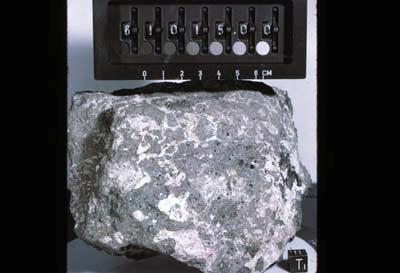
| Project Home | About the Scans | Browse Gallery | Image Map | Support Data | Resources | Ephemeris |
Featured Image - 12/09/2008
The Cayley Formation at Ptolemaeus Crater
Ptolemaeus crater in the central nearside lunar highlands has a relatively smooth floor compared to many other highlands craters (Figure 1). Relatively, smooth, flat and bright materials found in the lunar highlands are generally referred to as "light plains" because they are brighter (higher albedo) than the lunar maria. The material filling the crater floor in Ptolemaeus is part of the Cayley Formation. The Cayley Formation is also found at the Apollo 16 landing site.
Figure 1: Ptolemaeus crater is filled with light plains materials often called the Cayley Formation. The material filling the crater is bright and relatively smooth.
(Apollo Image AS16-M-0990 [NASA/JSC/Arizona State University])
Many different sources have been proposed for light plains materials. Suggestions for the formation of the light plains include: highlands volcanism, ash flows, and impact ejecta. After samples of the Cayley Formation were retrieved by astronauts on Apollo 16, laboratory analysis showed that they were impact breccias (rock and mineral fragments trapped in a silicic-rock matrix; a rock type formed during large impacts) -- Figure 2 is an example of an impact breccia. This analysis showed that at least parts of the Cayley Formation are composed of impact breccias and are associated with the basin-forming impacts (such as Imbrium, which formed ~ 3.9 billion years ago; or Orientale, which formed ~ 3.84 billion years ago), but the wide range of ages (4.0 - 3.65 billion years ago [Koehler et al. 1999]) associated with different units (Neukem 1977; Engel et al. 1987), leaves the source of some Cayley Formation light plains materials undetermined.

Figure 2: Lunar sample 61015 is an impact breccia composed of anorthosite (white mineral) and impact melt rock (Meyer 2005). This rock was collected by astronauts while on the lunar surface during the Apollo 16 mission. (Whilshire 1972 [ASU Digital Petrographic Slide Collection])
The light plains materials in Mendeleev crater are probably older than those in Ptolemaeus because the Mendeleev plains are more highly disrupted by subsequent craters than those of Ptolemaeus.
The wide range of ages for light plains materials leaves open the possibility for different formation mechanisms such as highlands volcanism. Due to the uncertainty about the formation mechanisms and compositions of all the light plains units, these materials are potential exploration targets for future lunar scouts.
References:
G. Neukum (1977) Different Ages of Lunar Light Plains, The Moon: 383-393.
Apollo Over the Moon: A View from Orbit (1978) H. Masursky, G.W. Colton, F. El-Baz, eds. NASA SP-362. http://www.hq.nasa.gov/office/pao/History/SP-362/contents.htm
S. Engle et al. (1987) Lunar Light Plains: Ages and Composition, Lunar and Planetary Science Conference: 262.
U. Koehler et al. (1999) North-Polar Lunar Light Plains: Ages and Compositional Observations, Workshop on New Views of the Moon 2: 34.
C. Meyer (2005) The Lunar Sample Compendium: 61015 (Draft).
Tweet
|
|
Space Exploration Resources |
|
 LPI LPI
|
